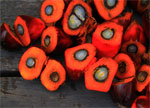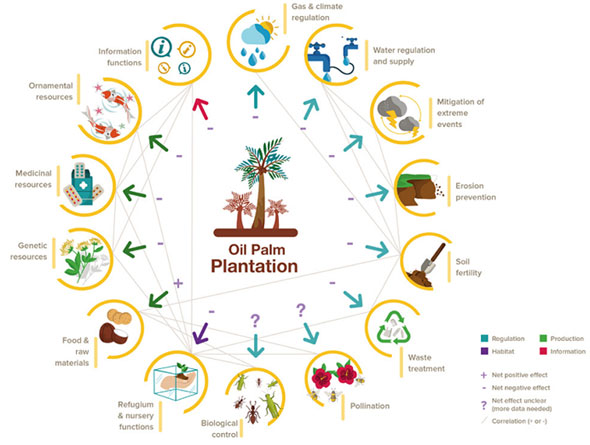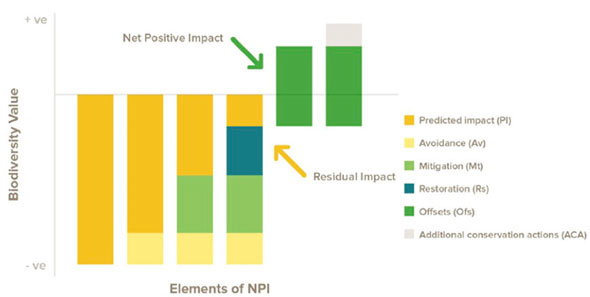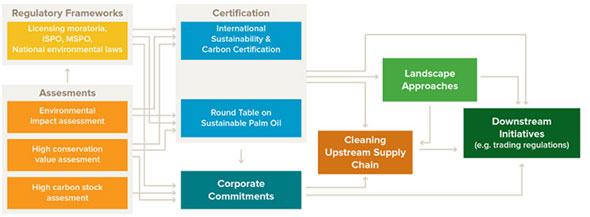

Sprachen:

Oil palm is the 3rd largest oil crop in terms of planted area behind soy and rapeseed. Because of its high yields, oil palm produces about 35% of all vegetable oils on less than 10% of the land allocated to oil crops. Palm oil is high in palmitic fatty acid and almost 75% of world production goes into food products, particularly cooking oil and processed oils and fats (e.g., margarine). Palm kernel oil is high in lauric fatty acid and is used mostly for soap and industrial purposes, as well as processed foods.
Palm oil is also used to produce biofuels but in the United States, the Renewable Fuel Standard requires that biomass-based diesel meets a lifecycle greenhouse gas emissions reduction of 20%, and the United States Environmental Protection Agency (EPA) analysis indicated that palm oil biofuels do not meet this minimum threshold needed to qualify as renewable fuel. A study that modelled land-based emissions under several biofuel mix scenarios in Europe found that across all conventional feedstocks considered, oil palm had the greatest emissions intensity (emissions per mega joule of biofuel consumed). Oil palm’s intensity was 1.5 times that of soybean, the second most emissions intensive feedstock, and was largely driven by carbon dioxide emissions from drainage of peatlands in Southeast Asia for oil palm development.
Even if the distinction is not always clear, oil palm has a large ‘smallholder’ sector, with in some countries up to 94% of the oil palm land allocated to ‘smallholders’ as compared to large landholders.
Palm oil is derived from the oil palm tree originating from Africa. The highest concentration of palm oil fields is in Indonesia and Malaysia, which provide 85% of the world production; it is also cultivated in western Africa and South America. Since the 1990s, it has become a global commodity widely used in processed foods, in good part because of its high yield. A palm oil plantation yields between 1 (in Africa) and 3.8 tons (in Indonesia) of oil per hectare, compared to 0.8t for rapeseed, 0.7t for sunflower and 0.5t for soy.
Oil palm is a tropical plant species. It needs high rainfall, adequate solar radiation and high humidity to maximize photosynthetic capacity. The cultivation of oil palm is mostly done in a monoculture, except in Africa where it is part of an agroforest system. Palm trees are planted about 10 meters apart so that their crowns do not overlap. Three years after planting, the trees start to bear fruits, and reach peak production after about 10 years. After 25 years the trees become too tall, complicating harvesting, and yields decline; plantations are then cut down and new palms are replanted. Oil palm cultivation is labor-intensive because harvesting is largely manual. This high labor requirement makes oil palm an important livelihood option is many regions.
Fresh fruits are harvested about every two weeks and are crushed to extract the oil from the kernel and the flesh of the fruit, separately. The oil from the fruit goes into food production, whereas the oil from the kernel is used mostly for soap and industrial purposes, but also for processed foods.
Oil palm plantations can take many forms that can be categorised into four main types:

The exact way small scale productions work vary from region to region and country to country, but they are a very important actors in the sector, since they produce around 40% of global palm oil.
The main direct impact on biodiversity of oil palm cultivation is the habitat loss caused by the deforestation and fire before planting. If, globally, oil palm development causes less than 0.5% of all deforestation, in some parts of the world, up to 50% of deforestation can be attributed to palm oil production. In Malaysia, most of the expansion of oil palm cultivation was done at the expense of forest areas. Oil palms can also be planted in areas that previously were croplands, pasture or shrub land. Between 2005 and 2015, industrial oil palm plantations accounted for 50% (2.1 Mha) of Borneo’s old-growth forest area loss.
Expansion of oil palm, without accounting for biodiversity, is not compatible with international biodiversity policies. Oil palm plantations are much less diverse than the rainforests they replace, and species diversity decreases significantly when forests are converted. The net impact of oil palm is the result of a complex interplay between rodents, snakes, local people, and the loss of ecosystem services provided by the natural forests that palm plantations have replaced.
Given the commonly mono-cultural nature of oil palm cultivation, the simple, one canopy layer structure of plantations, the almost complete absence of leaf litter, the lack of understory vegetation and woody debris, and the more open canopy, it is hardly surprising that the species diversity of oil palm concessions is lower than that of natural forests.
Smallholder plantations tend to harbor higher diversity than industrial ones. Conflicts between wildlife and humans tend to increase when oil palm plantations are established, with species like orangutans and tigers being displaced. In mixed landscapes of oil palm plantations and forests, the plantations can maintain the ecological connectivity between forest areas.
Some species, mainly generalists like pigs and some snakes, benefit from oil palm plantations because of the availability of food like oil seeds for the pigs, and rodents like rats and squirrels for the snakes. In turn, the pigs are killed for meat, and the snakes are used for their skins, mainly by plantation workers.
| Box : The case of snakes |
| For at least eight Asian snake species there is evidence that they thrive in oil palm plantations, and appear to have increased their densities in response to increased prey abundance. This increase in abundance has improved the ability of local people to sustainably harvest snakes, which in turn improves their capacity to generate income from their natural resources. Nevertheless, more broadly, despite oil palm expansion benefitting a handful of snake species, populations of many others have suffered. Southeast Asia is home to more than 400 species of snakes, yet only eight (2%) are so far known to thrive in oil palm plantations. Others occupy specialised niches that are unavailable outside the natural forests that oil palm plantations have replaced and have likely been extirpated from large areas of their former range. |
The cultivation and development of oil palm has significant negative impacts on biodiversity. It is difficult to compare the biodiversity impacts of oil palm to other agricultural systems directly, but it is clear that other agricultures also have a significant impact on biodiversity. For example, in the Amazon, 150 million hectares have been lost and around 80% of this was due to cattle ranching. Another major crop, soy, also has a large negative impact on biodiversity, supporting an impoverished bird diversity compared to natural ecosystems in Brazil and Argentina. However, given the rising demand for vegetable oils and that oil palm produces much more oil than other oil crops for the same cultivated area, moving away from palm oil might not be the best solution to obtain net positive effect on biodiversity.

Other indirect impacts of palm oil production include the greenhouse gas emissions related to deforestation, the use of fire for clearing land, water quality, freshwater, species diversity, invasive species associated with oil palm, pest-spillover effects and secondary impacts of hunting.
Water quality in and downstream is also affected by fertilizers, pesticides, and other chemicals all influence local drainage and impact water quality and aquatic habitats. The effluent from most modern mills is generally minimized as much as possible, but release into local rivers has been known to cause severe impacts on aquatic ecosystems. It is also generally believed that the release of nutrients and silt from palm oil and other land developments will negatively impact aquatic habitats nearby— including fisheries and coral reefs.
The main strategy that has been used to mitigate the impact of oil palm cultivation has been to address the loss of natural forests and of peat lands with actions ranging from government regulation to voluntary actions. Initiatives focusing on sustainability of the industry have mostly reacted to the main causes of direct loss of biodiversity, which are land clearing and fires during the expansion of palm oil cultivation. Even if some smallholdings, for example, may be under more hunting pressure than well-managed large-scale plantations, preliminary research from Peninsular Malaysia shows slightly higher levels of biodiversity in oil palm smallholdings, but this is likely context specific and should not be generalized to other oil palm dominated landscapes in the tropics.
Less effort has been made to address the underlying causes, such as the growing demand for vegetable oil and the political economy of land acquisition and development. The direct links between weaknesses in land governance, including corruption and collusion over obtaining oil palm development permits, are well established in the academic literature on forest management and extensively documented in the “grey literature” on oil palm.
Over the past two decades, a large range of environmental governance initiatives have emerged to address sustainability in the industry. These include voluntary certification and corporate commitments, state led regulations and hybrid landscape approaches. There is high complementarity between these initiatives, and together they cover a broad conservation scope and stakeholders. At present, there is still limited evidence of the effectiveness of sustainability initiatives in the industry.
Various international organisations and processes are involved to establish intergovernmental targets of direct relevance to oil palm and biodiversity conservation. These include The Convention on Biological Diversity (CBD)1 , most of the 17 Sustainable Development Goals of the United Nations2, and the climate change and desertification related conventions. For example, 20 specific Aichi Targets of the CBD Strategic Plan for Biodiversity 2011–20203 are directly relevant to oil palm production and consumption.
Among the number of steps at which mitigation action can be taken in order to offset and minimize the predicted negative impact are:

The mitigation hierarchy, for example, is a sequence of steps taken throughout a project’s lifecycle starting with avoidance of impacts, minimization of inevitable impacts, on-site restoration and, finally, compensation or biodiversity offsets if required.
There are certification systems in place, such as the Roundtable on Sustainable Palm Oil4, that require producers to avoid clearing primary forests, to protect rivers, and to avoid fires and control pollution. Since the last decade, as public awareness of the problem of deforestation grows, there is a trend of individual corporate commitments of “no deforestation”, and the palm oil industry is one of the sectors where this level of commitment is the highest, with more than half of the companies having such a commitment.
In terms of governmental intervention, there can be policies in the countries where oil palms are grown, like the moratorium on deforestation in Indonesia, or in the countries that import palm oil, like the Amsterdam Declaration5 that support a fully sustainable supply chain.
Also, companies with “no deforestation” commitments are in a powerful position to drive behavioral change upstream in the supply chain. Buyer demands are thought to serve as a leverage point to mobilize sustainability practices of less visible producers such as non-certified small-to medium-sized companies and smallholders with insufficient incentives or capacity to prioritize conservation. Eventually, it is important to underline that most of the sustainability initiatives in the sector complement each other and that these conservation interventions together cover a broader scope than any one of them does individually. They have different conservation scopes, are applied at different scales, and target different stakeholders and markets.

1 www.cbd.int/![]()
2 www.un.org/sustainabledevelopment/sustainable-development-goals/![]()
3 ![]()
4 https://rspo.org/about![]()
5 www.euandgvc.nl/documents/publications/2015/december/7/declarations-palm-oil![]()
The global demand for vegetable oil is growing fast. The demand in 2050 is projected to be double of what it was in 2008, with a demand of 310 million tons, up from about 165 million tons in 2013. It is possible to increase the yield of current production through better management or use of more productive varieties, for instance, but that does not necessarily mean that there would not be more development and more land conversion, since palm oil production is a lucrative endeavor for investors.
There is room for cultivation of oil palms in Africa and South America, where the production is still relatively small, but the environmental impact of expansion of oil palm plantations in those areas is understudied.
Governments of producing countries have also reacted to international debates on oil palm and deforestation:
Anyway, a potential substitute may come in the form of a yeast, Metschnikowia pulcherrima, which is used as a biological control agent in the South African wine industry and is able to produce oil with a similar lipid profile to palm oil.
The most significant gaps that require further research are:

This summary is free and ad-free, as is all of our content. You can help us remain free and independant as well as to develop new ways to communicate science by becoming a Patron!